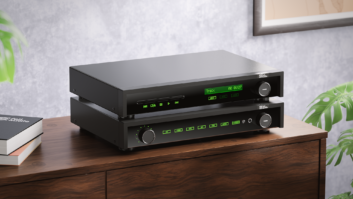Chances are, you have fallen victim to manufacturer hype at least once during your business–or even personal–life. Maybe a product that was supposed to be shipped in January didn’t make it to your shelves until June. Or, the manufacturer from whom you purchased product went out of business, leaving you with no technical support or warranty options. Or, the product never made it to market, period, having been written off by its manufacturer as being too expensive to realistically produce and earning the dubious label of “vaporware” among frustrated customers.
Believe it or not, manufacturers are sensitive to these issues. Perhaps the empty promises–and the ensuing consequences–of the dot-com era have resulted in a detailed reflection of the processes behind bringing products to market. At the same time, dealers, who must service an increasingly informed and sophisticated clientele, are not as forgiving when products don’t measure up. Although no one boldly declares that broken promises and vaporware will disappear, many manufacturers are working on the problem.
“One of the issues is that there is not sufficient time to do the kind of detailed marketing studies that a more relaxed development schedule would permit,” said Marty Zanfino, manager of product development, Mitsubishi Electronics America Inc. “The consumer is better informed today and, therefore, more demanding. If they want a new TV and they want to buy it this month, they have many good products to select from. The competition is good enough that many consumers won’t wait for a particular brand to introduce a product with the features they want. Also, we have to make judgement calls based on less information than we would prefer, because we are working in a more restricted time frame. It adds a level of uncertainty that we wouldn’t have in a more relaxed setting.” Manufacturers are constantly weighing the advantages and disadvantages of being first to market with new technology, Zanfino explained. “There is something that every marketing and strategy textbook refers to as ‘the mover advantage,’” he said. “When you are first, you have 100 percent of the market share. It may be small, but you have 100 percent, and as the market develops it is easier to hold onto a larger share if you are first. That is not an assurance, but it is easier; the wind it at your back instead of in your face.” There is a catch, however: “The downside is that the first generation usually costs more money to develop than the second or third generations,” Zanfino continued. “You’re burning through a lot of cash developing a first-generation model, and if it doesn’t sell well, you will have a large financial loss. That’s okay if it’s part of a larger plan, if you are planning on getting market share as part of a long-term strategy. Over the course of several years, it may make very good financial sense to lose money in the first year.” “There are certain risks in being first to market,” Brian Towne, national product manager at Kenwood USA Corp., agreed. “Certainly being first with a product that nobody wants is useless. The key is to identify how your product and your brand are going to set in. With being first to market, challenges such as education and support are much more consuming, and take up a lot more resources than it would if you were just building a better mousetrap.”
While manufacturer hype may drive some dealers crazy, manufacturers, too, claim that balancing the promotion of a new product with its actual ship date is a task that makes even the most seasoned veterans sweat. Chris Kane, director of sales and marketing at AudioControl, says this is a constant challenge.
“With the custom market, we have a rule of thumb that we wouldn’t show anything at trade shows that wasn’t going to ship within 90 days,” Kane said. “We’ve been religious about that, and it’s worked well for us. But, in the custom market there is a very long buying cycle. There is the period of time when the custom installers become aware of the product through the reps. Once they are aware of it, and they test it and feel comfortable with it, there is the specifying process. That can last 90-100 days.”
Then, Kane explained, the specs must be accepted and the job comes to fruition, which in some cases can be another six months, especially if they are building a 15,000-20,000 square-foot house. “Sometimes it can be a year and a half from the time we showed the product before we really start to see substantial sales on it,” Kane added.
RBH Sound, which aims to be first to market with many of its loudspeaker products, overestimates product runs to avoid confusion surrounding ship dates. “It’s important to get the market excited about a product and build demand before the supply of product is actually available,” said RBH sales manager, Daren Egan. “However, announcing a new product concept too early can allow the competition access to very valuable ideas or concepts, and possibly frustrate customers. You tend to lose credibility with customers if a product release date is set too soon compared to the actual release date. The trick is to overestimate production runs so you can try to deliver the product before the announced release date.”
For some companies, being first to market isn’t really that big of an issue. “For broad-based, mass-distributed products by large companies, being first to market and first in the public’s mind is really important, and you have the edge where it is very hard for other companies to catch up,” said Triad Speakers president, Larry Pexton. “In the business that we are in, which is specialty, custom-oriented high-end speaker manufacturing, it’s more of an evolution. Generally, we try to focus on things we know are going to work for about two-thirds of our development. There are so many improvements that we know how to do that we haven’t done yet, that doing speculative development is something we don’t do a lot of, except for about a third of the time.”
Brad Smith, president of Audio Video Design, a custom installation firm based in Wellesley, Massachusetts, prefers to act as a beta test site for new product when he can. “When we get a product in, we will run it through its paces in our engineering department. Then we come up with a list of problems that we have with it; we analyze those problems, and then we talk with the manufacturer about them,” he explained. “When we are fully satisfied that the manufacturer has eliminated those problems, then it’s a question of whether we think it’s going to be product that is going to be produced in enough quantity and that we are not going to be left holding the bag in a year.”
Customer installers must also consider the risks involved in taking on new products–not only because of the technical support issues that may be involved, but because of what can happen if these products are not all they are cracked up to be.
“When a company brings us a new product that is either built into the home or could impact life safety, we owe it both to the client and to our company to proceed with great care,” said Larry Whitney, president and partner at Western Audio Video in La Honda, California. “Any time it impacts the infrastructure of the home–be it lighting or telecommunications –where a failure in our system or a level of automation that activates at some point when there might be an emergency, we literally could put the client’s life in a poor safety situation. Integrators, who are the interface between the manufacturers and the client, owe it to themselves and their companies, and their clients, to proceed with great caution.” For Smith, and custom installation businesses in general, the products they install must do what they are supposed to. “If you’re selling your client a concept, the client has to have the finished concept–not the starting concept,” Smith said. “You can sell vaporware, but you can’t install it. When you hand the keys to the client, so to speak, they have to be able to sit down in the jalopy you sold them and say: ‘I love it’.”
Carolyn Heinze works from her media services firm, Punchface Propaganda Machine.







